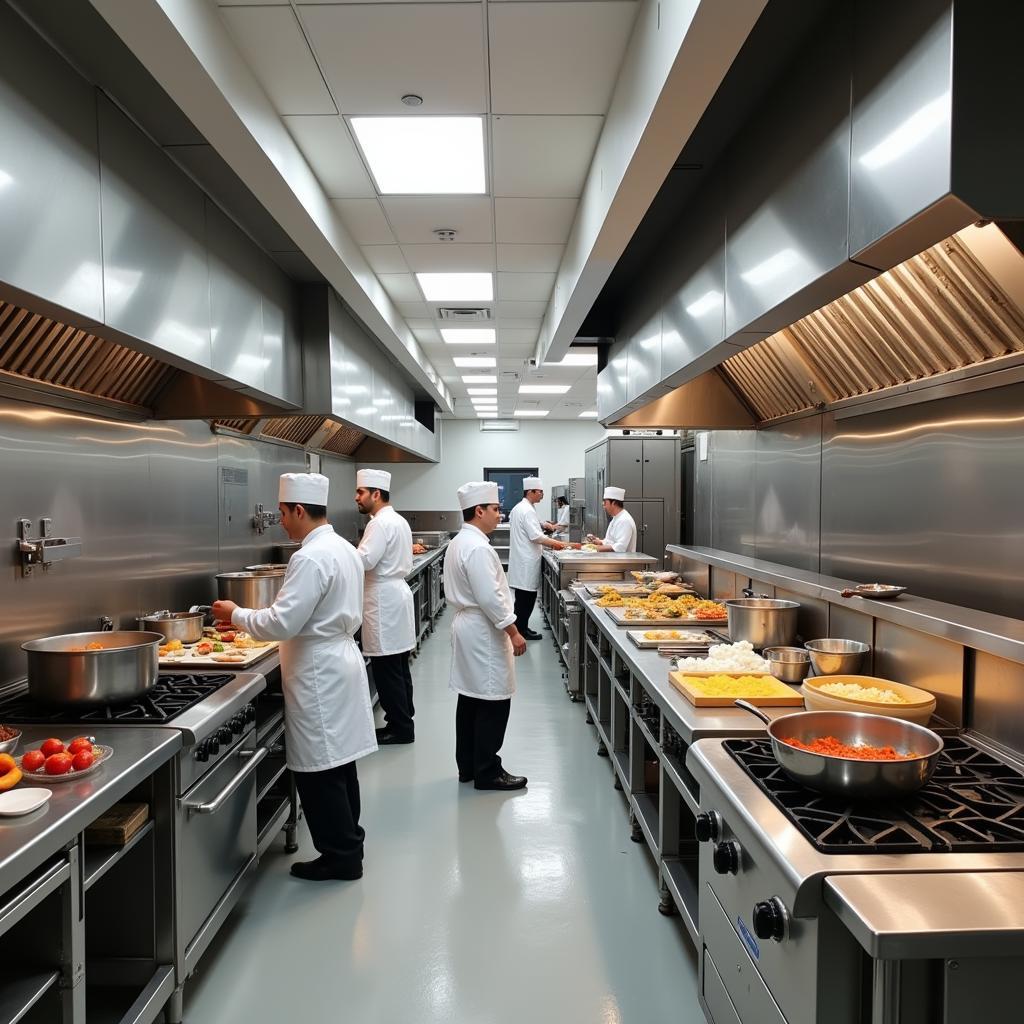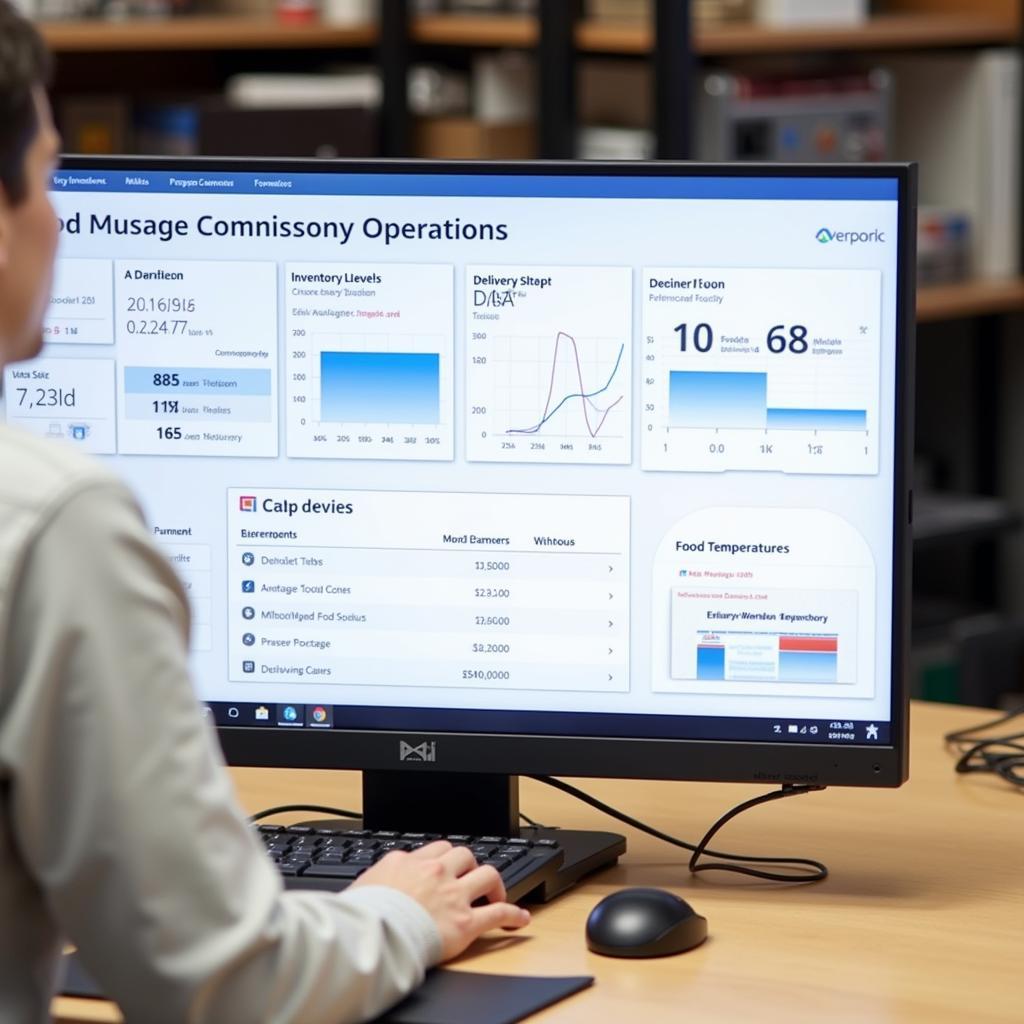A well-oiled Commissary Food Service System is the backbone of many large-scale food operations. From schools and hospitals to corporate cafeterias and prisons, these systems ensure efficient food production, storage, and distribution. This comprehensive guide explores the intricacies of commissary food service, covering its benefits, challenges, and best practices.
 Commissary kitchen bustling with food preparation activities
Commissary kitchen bustling with food preparation activities
What is a Commissary Food Service System?
A commissary food service system, sometimes referred to as a centralized kitchen, involves preparing food in a central location and then transporting it to satellite locations for serving. This system differs from traditional on-site food preparation, where each location has its own kitchen. Commissary kitchens often leverage specialized equipment for large-scale production and packaging, streamlining the entire food service process. It’s a popular choice for organizations managing multiple food service outlets. Do food trucks have running water, often relying on a commissary system for water access and food prep? They often do, especially for initial prep and cleaning tasks.
Benefits of a Commissary Food Service System
Centralized food production offers several key advantages:
- Cost Savings: Bulk purchasing and reduced labor costs due to centralized operations can lead to significant savings.
- Quality Control: Standardized recipes and procedures ensure consistent food quality across all locations.
- Efficiency: Streamlined production and distribution optimize efficiency, minimizing food waste and maximizing resource utilization.
- Menu Consistency: Diners can expect the same menu and quality of food regardless of the serving location.
- Improved Sanitation: Centralized sanitation protocols and rigorous quality control measures enhance food safety.
Challenges of a Commissary Food Service System
While commissary kitchens offer numerous benefits, they also present certain challenges:
- Transportation Logistics: Efficient transportation and temperature control are critical to maintaining food quality and safety during transport.
- Equipment Investment: Setting up a commissary kitchen requires a substantial initial investment in specialized equipment.
- Menu Flexibility: Adapting to specific dietary needs or regional preferences can be challenging in a centralized system.
How to Optimize Your Commissary Food Service System
Implementing best practices can help overcome challenges and maximize the benefits:
- Invest in High-Quality Equipment: Choose reliable equipment designed for large-scale food production and transport.
- Develop Standardized Recipes: Ensure consistent quality and simplify training for kitchen staff.
- Implement Rigorous Quality Control: Regularly monitor food quality and safety throughout the production and distribution process.
- Optimize Transportation Logistics: Invest in insulated containers and temperature-controlled vehicles to maintain food quality.
- Embrace Technology: Utilize software for inventory management, menu planning, and tracking food deliveries.
 Modern technology in commissary food service management
Modern technology in commissary food service management
What are the Common Questions about Commissary Food Service Systems?
One common question is about specialized equipment. Think about prison food trays; these trays are designed specifically for the unique requirements of a correctional facility’s commissary system. Another question concerns customization. Can a commissary system handle customized orders? Yes, with careful planning and advanced technology, a certain level of customization is possible.
“A successful commissary food service system hinges on meticulous planning and execution,” says renowned food service consultant, Amelia Carter. “Investing in robust technology and focusing on quality control are crucial for long-term success.”
Conclusion
A commissary food service system offers significant advantages for organizations managing large-scale food operations. While challenges exist, implementing best practices and investing in the right equipment can lead to cost savings, improved quality control, and enhanced efficiency. For organizations seeking to streamline their food service operations, a well-managed commissary food service system is a powerful solution. Prison food trays and jail food trays are examples of how these systems adapt to specific needs.
FAQ
- What is the main advantage of a commissary kitchen? Cost savings and quality control.
- What are the challenges of a commissary food service system? Transportation and initial investment.
- How can I improve the efficiency of my commissary kitchen? Standardized recipes and technology.
- Is food safety compromised in a commissary system? No, rigorous quality control enhances safety.
- How can I customize a commissary menu? Careful planning and technology can facilitate customization.
- What type of equipment is essential for a commissary kitchen? Large-scale production and transport equipment.
- How does a commissary system handle special dietary needs? Menu planning can incorporate special diets.
Scenarios and further reading
If you are considering setting up a commissary food service system for a school, hospital, or large event, be sure to explore specific guidelines and regulations.
For further questions regarding jail food trays or prison food trays, visit our dedicated pages for more information.
Contact Us
Need help with your food service needs? Contact us at: Phone: 02437655121, Email: minacones@gmail.com or visit us at 3PGH+8R9, ĐT70A, thôn Trung, Bắc Từ Liêm, Hà Nội, Việt Nam. We offer 24/7 customer support.